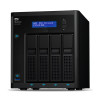Western Digital My Cloud PR4100 User Manual - Page 62
Viewing Hard Disk Drive Information, Viewing S.M.A.R.T Data Information, iSCSI Storage
 |
View all Western Digital My Cloud PR4100 manuals
Add to My Manuals
Save this manual to your list of manuals |
Page 62 highlights
MANAGING STORAGE The Disk Status screen consists of the following areas: Disks Profile: This area displays the general status of all of the disk drives on your device. System Disks: This area identifies the drives in your device, the status of each drive, and the amount of space on that drive. Note: If a drive is not supported, the status is not compatible. Viewing Hard Disk Drive Information Use the following steps to view status of the disks on your My Cloud device. 1. On the Storage page, click Disk Status, if not already selected. 2. In the System Disks area, select Drive next to the disk for which you'd like to view information. 3. Review the hard drive information and click Close. The Hard Drive Information screen displays the following data: Vendor Model Serial Number Capacity Firmware Version The vendor from whom the hard drive was obtained. The model number of the hard drive selected. The serial number of the hard drive selected. The capacity of the hard drive selected. The current firmware version used on the drive selected. Viewing S.M.A.R.T Data Information Self-Monitoring, Analysis and Reporting Technology (S.M.A.R.T.) data detects and reports on various indicators of drive reliability with the intent of anticipating hardware failures. Use the following steps to view S.M.A.R.T data information concerning your My Cloud device drives. 1. On the Storage page, click Disk Status, if not already selected. 2. In the System Disks area, select S.M.A.R.T Data next to the disk for which you'd like to view information. 3. Review the S.M.A.R.T drive information, then click Close. iSCSI Storage Internet SCSI (iSCSI) is an industry standard developed to enable transmission of iSCSI block storage commands and data over an existing IP network by using the TCP/IP protocol. The encapsulated iSCSI commands and data can be transmitted over a local area network (LAN) or a wide area network (WAN). As with traditional iSCSI, an iSCSI storage solution requires at least one "initiator" residing on the client computer and at least one "target" residing on the storage server. Once the connection is established between the iSCSI initiator and the iSCSI target, the operating system on the iSCSI initiator sees the storage as a local storage device that can be formatted, read, and written in the usual manner. Your My Cloud device allows you to create and manage iSCSI targets. The iSCSI target provides storage, similar to a local hard disk drive, but is accessed over a network rather than locally. The iSCSI target is protected by the underlying RAID structure of the My Cloud device. MY CLOUD USER MANUAL 56















